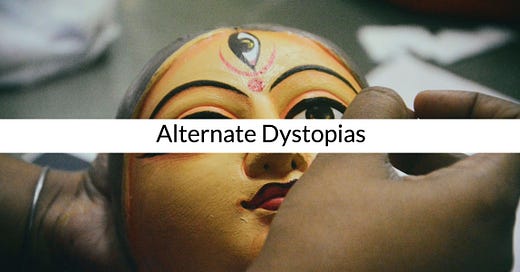Alternate Dystopias
As you might know, I have been writing extensively about demonetization. In case you have missed some of the articles on medium, they are…

As you might know, I have been writing extensively about demonetization. In case you have missed some of the articles on medium, they are here:
The Anti-Corruption Cult
I was struck by Anna Hazare’s support for demonetization.rajesh.io
Permanent Demonetization
It’s an error to compare today’s demonetization to what happened in 1946 and 1978, for those were simply cases of…rajesh.io
Bye Bye Lalaland
I am old enough to remember the BJP of Madan Lal Khurana. Not when he was the chief minister of Delhi, but much before…rajesh.io
While demonetization is undoubtedly important — perhaps the single most important economic-financial event anywhere in the world after the 2008 recession — and it affects the lives of the Indian poor much more than that of the rich, I have another reason for writing these articles:
Demonetization is a glimpse into a non-western dystopia.
We don’t usually associate “India” with “Future,” or to the extent we do, it’s an adjunct to a typically western future. That’s as true of dystopias as it is of utopias. For example, when we think of a surveillance state, we think of Orwell and 1984, or in real life, Snowden and the NSA. When we think of robots taking over the earth and enslaving us, we keep Huxley’s “Brave New World” or “The Matrix” in mind. Kafka, Huxley and Orwell present western dystopias as if they were universal; so does every Hollywood movie from Dr. Strangelove to Minority Report. They don’t quite work for me. We can read these books and watch these movies for entertainment and empathy, but we can’t fully embrace that world.
In this imperial geography of wretchedness, Indians don’t have dystopia, we only have poverty.
So what if we don’t have dystopia, we don’t have utopia either. There’s only so much we can borrow from a western, often christian, idea of the good life or the terrible life before it stops meeting our imaginative needs.
In contrast, demonetization points to a distinctly Indian future. Not a future that I happen to agree with, but it’s still ours. A future that resembles what we see in the west, such as a hegemonic Indian state that’s hand in hand with big business. It’s also uniquely Indian.
Just consider one issue that dominates headlines in the west: jobs. Jobs being taken away by people in China and India and by robots everywhere. That’s not what we Indians worry about. Instead, we worry about creating jobs for the 10 million young people who are entering the workforce every year. Both the scale and the nature of the problem dwarfs anything you see in the west.
Also consider the resistance to demonetization: it’s coming from people like Mamta Banerjee, who’s about as far from the suited white (or light-skinned brown) man signing treaties in Paris as one can imagine. Let’s also not forget Modi’s bete noire, Arvind Kejriwal. It’s Kejriwal who brought the attack against corruption to the national stage, even as Modi took it all the way to Janpath.
So what did Kejriwal do that Modi did better with demonetization. The odd-even policy comes to mind. Like demonetization, it was a technocratic intervention with widespread effects. Modi’s answer is simple: if you can take 50% the cars off Delhi’s roads, I can take 86% of currency off India’s homes.
Coming to think of it, in this new language of data driven revolution, the response to odd-even is demonetization. The ruling party’s slogan: anything Kejriwal can do, Modi can do better.
What will we see next in this arms race? I don’t know, but what’s clear is that we are entering a new phase of history.
My point being: whether it’s financial turmoil, pollution or climate change, the future is being created in India by people who don’t fit the western mold.
It’s a future worth paying attention to, not just with our economist or activist hats, but also with our creative hats. We have plenty of fodder for our speculative imagination.



